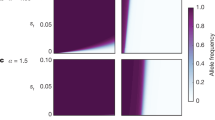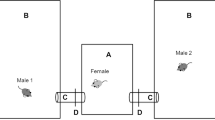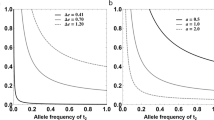Abstract
Females express mate preferences for genetically dissimilar males1, especially with respect to the major histocompatibility complex, MHC2,3, and for males whose sexually selected signals indicate high genetic quality4,5. The balance of selection pressure on each trait will depend on how females weight these desirable qualities under different conditions6, but this has not been tested empirically. Here we show in mice that although MHC dissimilarity and a 'good genes' indicator (investment in scent-marking) both have a role in determining female preference, their relative influence can vary depending on the degree of variability in each trait among available males. Such interactions between condition-dependent and disassortative mate choice criteria suggest a mechanism by which female choice can contribute to maintenance of additive genetic variance in both the MHC and condition-dependent traits, even under consistent directional selection.
This is a preview of subscription content, access via your institution
Access options
Subscribe to this journal
Receive 12 print issues and online access
$209.00 per year
only $17.42 per issue
Buy this article
- Purchase on Springer Link
- Instant access to full article PDF
Prices may be subject to local taxes which are calculated during checkout

Similar content being viewed by others
References
Isles, A.R., Baum, M.J., Ma, D., Keverne, E.B. & Allen, N.D. Urinary odour preferences in mice. Nature 409, 783–784 (2001).
Yamazaki, K. et al. Familial imprinting determines H-2 selective mating preferences. Science 240, 1331–1332 (1988).
Potts, W.K., Manning, C.J. & Wakeland, E.K. Mating patterns in seminatural populations of mice influenced by MHC genotype. Nature 352, 619–621 (1991).
Petrie, M. Improved growth and survival of offspring of peacocks with more elaborate trains. Nature 371, 598–599 (1994).
Hasselquist, D., Bensch, S. & von Schantz, T. Correlation between male song repertoire, extra-pair paternity and offspring survival in the great reed warbler. Nature 381, 229–232 (1996).
Colegrave, N., Kotiaho, J.S. & Tomkins, J.L. Mate choice or polyandry: reconciling genetic compatibility and good genes sexual selection. Evol. Ecol. Res. 4, 911–917 (2002).
Brown, J.L. & Eklund, A. Kin recognition and the major histocompatibility complex: an integrative review. Amer. Nat. 143, 435–461 (1994).
Penn, D.J. & Potts, W.K. The evolution of mating preferences and major histocompatibility genes. Amer. Nat. 153, 145–164 (1999).
Penn, D.J., Damjanovich, K. & Potts, W.K. MHC heterozygosity confers a selective advantage against multiple-strain infections. Proc. Natl. Acad. Sci. USA 99, 11260–11264 (2002).
Yamaguchi, M. et al. Distinctive urinary odors governed by the major histocompatibility locus of the mouse. Proc. Natl. Acad. Sci. USA 78, 5817–5820 (1981).
Gosling, L.M. & Roberts, S.C. Scent-marking by male mammals: cheat-proof signals to competitors and mates. Adv. Stud. Behav. 30, 169–217 (2001).
Novotny, M., Harvey, S. & Jemiolo, B. Chemistry of male dominance in the house mouse, Mus domesticus. Experientia 46, 109–113 (1990).
Gosling, L.M., Roberts, S.C., Thornton, E.A. & Andrew, M.J. Life history costs of olfactory status signalling in mice. Behav. Ecol. Sociobiol. 48, 328–332 (2000).
Desjardins, C., Maruniak, J.A. & Bronson, F.H. Social rank in house mice: differentiation revealed by ultraviolet visualization of urinary marking patterns. Science 182, 939–941 (1973).
Zahavi, A. Mate selection: a selection for a handicap. J. Theor. Biol. 53, 205–214 (1975).
Hayashi, S. Social condition influences sexual attractiveness of dominant male mice. Zool. Science 7, 889–894 (1990).
Mossman, C.A. & Drickamer, L.C. Odor preferences of female house mice (Mus domesticus) in seminatural enclosures. J. Comp. Psychol. 110, 131–138 (1996).
Rich, T.J. & Hurst, J.L. Scent marks as reliable signals of the competitive ability of mates. Anim. Behav. 56, 727–735 (1998).
Horne, T.J. & Ylonen, H. Heritabilities of dominance-related traits in male bank voles (Clethrionomys glareolus). Evolution 52, 894–899 (1998).
Drickamer, L.C. Estrous female house mice discriminate dominant from subordinate males and sons of dominant from sons of subordinate males by odour cues. Anim. Behav. 43, 868–870 (1992).
von Schantz, T., Wittzell, H., Goransson, G. & Grahn, M. Mate choice, male condition-dependent ornamentation and MHC in the pheasant. Hereditas 127, 133–140 (1997).
Eggert, F., Höller, C., Luszyk, D., Müller-Rucholtz, W. & Ferstl, R. MHC-associated and MHC-independent urinary chemosignals in mice. Physiol. Behav. 59, 57–62 (1996).
Yamazaki, K. et al. Control of mating preferences in mice by genes in the major histocompatability complex. J. Exp. Med. 144, 1324–1335 (1976).
Jordan, W.C. & Bruford, M.W. New perspectives on mate choice and the MHC. Heredity 81, 239–245 (1998).
Wedekind, C., Seebeck, T., Bettens, F. & Paepke, A.J. MHC-dependent mate preferences in humans. Proc. R. Soc. Lond. B 260, 245–249 (1995).
Edwards, S.V. & Hedrick, P.W. Evolution and ecology of MHC molecules: from genomics to sexual selection. Trends Ecol. Evol. 13, 305–311 (1998).
Potts, W.K. & Wakeland, E.K. Evolution of MHC genetic diversity: a tale of incest, pestilence and sexual preference. Trends Genet. 9, 408–412 (1993).
Potts, W.K. & Slev, P.R. Pathogen-based models favoring MHC genetic diversity. Immunol. Rev. 143, 181–197 (1995).
Pomiankowski, A. & Møller, A.P. A resolution of the lek paradox. Proc. R. Soc. Lond. B 260, 21–29 (1995).
Kotiaho, J.S., Simmons, L.W. & Tomkins, J.L. Towards a resolution of the lek paradox. Nature 410, 684–686 (2001).
Acknowledgements
We thank M. Bateson, F. Gilbert, M. Hale, W. Jordan, J. Kotiaho, M. Petrie and C. Rowe for their comments. The work was funded by the Leverhulme Trust.
Author information
Authors and Affiliations
Corresponding author
Ethics declarations
Competing interests
The authors declare no competing financial interests.
Rights and permissions
About this article
Cite this article
Roberts, S., Gosling, L. Genetic similarity and quality interact in mate choice decisions by female mice. Nat Genet 35, 103–106 (2003). https://doi.org/10.1038/ng1231
Received:
Accepted:
Published:
Issue Date:
DOI: https://doi.org/10.1038/ng1231
This article is cited by
-
MHC class I diversity predicts non-random mating in Chinese alligators (Alligator sinensis)
Heredity (2019)
-
Sex pheromone levels are associated with paternity rate in brown rats
Behavioral Ecology and Sociobiology (2019)
-
Female nursing partner choice in a population of wild house mice (Mus musculus domesticus)
Frontiers in Zoology (2018)
-
No speed dating please! Patterns of social preference in male and female house mice
Frontiers in Zoology (2017)
-
Asian house rats may facilitate their invasive success through suppressing brown rats in chronic interaction
Frontiers in Zoology (2017)



